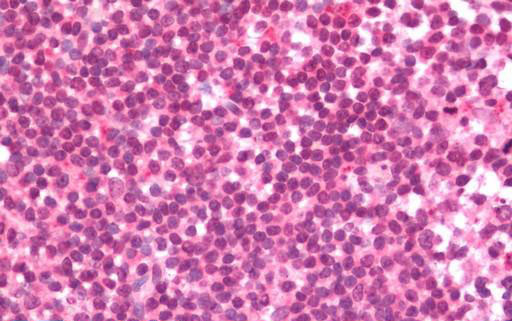APOBEC3C Antibody
Rabbit Polyclonal Antibody
- SPECIFICATION
- CITATIONS
- PROTOCOLS
- BACKGROUND

Application
| WB, IHC-P |
|---|---|
| Primary Accession | Q9NRW3 |
| Other Accession | 27350 |
| Reactivity | Human |
| Host | Rabbit |
| Clonality | Polyclonal |
| Isotype | IgG |
| Calculated MW | 22826 Da |
| Dilution | IHC-P (5 µg/ml), WB (1:500 - 1:3000), |
| Gene ID | 27350 |
|---|---|
| Other Names | APOBEC3C, A3C, APOBEC1-like, APOBEC1L, ARP5, BK150C2.3, Phorbolin i, ARDC2, ARDC4, PBI |
| Target/Specificity | Human APOBEC3C. Cross-reactivity with APOBEC3C from other sources has not been determined. |
| Reconstitution & Storage | PBS, pH 7.4, 0.02% sodium azide. Store at 4°C short term. Aliquot and store at -20°C long term. Avoid freeze-thaw cycles. |
| Precautions | APOBEC3C Antibody is for research use only and not for use in diagnostic or therapeutic procedures. |
| Name | APOBEC3C |
|---|---|
| Synonyms | APOBEC1L, PBI |
| Function | DNA deaminase (cytidine deaminase) which acts as an inhibitor of retrovirus replication and retrotransposon mobility via deaminase- dependent and -independent mechanisms. After the penetration of retroviral nucleocapsids into target cells of infection and the initiation of reverse transcription, it can induce the conversion of cytosine to uracil in the minus-sense single-strand viral DNA, leading to G-to-A hypermutations in the subsequent plus-strand viral DNA. The resultant detrimental levels of mutations in the proviral genome, along with a deamination-independent mechanism that works prior to the proviral integration, together exert efficient antiretroviral effects in infected target cells. Selectively targets single-stranded DNA and does not deaminate double-stranded DNA or single- or double-stranded RNA. Exhibits antiviral activity against simian immunodeficiency virus (SIV), hepatitis B virus (HBV), herpes simplex virus 1 (HHV-1) and Epstein-Barr virus (EBV) and may inhibit the mobility of LTR and non- LTR retrotransposons. May also play a role in the epigenetic regulation of gene expression through the process of active DNA demethylation. |
| Cellular Location | Nucleus. Cytoplasm |
| Tissue Location | Expressed in spleen, testes, peripherical blood lymphocytes, heart, thymus, prostate and ovary |

Thousands of laboratories across the world have published research that depended on the performance of antibodies from Abcepta to advance their research. Check out links to articles that cite our products in major peer-reviewed journals, organized by research category.
info@abcepta.com, and receive a free "I Love Antibodies" mug.
Provided below are standard protocols that you may find useful for product applications.
Background
DNA deaminase (cytidine deaminase) which acts as an inhibitor of retrovirus replication and retrotransposon mobility via deaminase-dependent and -independent mechanisms. After the penetration of retroviral nucleocapsids into target cells of infection and the initiation of reverse transcription, it can induce the conversion of cytosine to uracil in the minus-sense single-strand viral DNA, leading to G-to-A hypermutations in the subsequent plus-strand viral DNA. The resultant detrimental levels of mutations in the proviral genome, along with a deamination- independent mechanism that works prior to the proviral integration, together exert efficient antiretroviral effects in infected target cells. Selectively targets single-stranded DNA and does not deaminate double-stranded DNA or single-or double- stranded RNA. Exhibits antiviral activity against simian immunodeficiency virus (SIV), hepatitis B virus (HBV), herpes simplex virus 1 (HHV-1) and Epstein-Barr virus (EBV) and may inhibit the mobility of LTR and non-LTR retrotransposons. May also play a role in the epigenetic regulation of gene expression through the process of active DNA demethylation.
References
Gu J.,et al.Submitted (JUL-1999) to the EMBL/GenBank/DDBJ databases.
Collins J.E.,et al.Genome Biol. 5:R84.1-R84.11(2004).
Ota T.,et al.Nat. Genet. 36:40-45(2004).
Dunham I.,et al.Nature 402:489-495(1999).
Mural R.J.,et al.Submitted (JUL-2005) to the EMBL/GenBank/DDBJ databases.
If you have used an Abcepta product and would like to share how it has performed, please click on the "Submit Review" button and provide the requested information. Our staff will examine and post your review and contact you if needed.
If you have any additional inquiries please email technical services at tech@abcepta.com.













 Foundational characteristics of cancer include proliferation, angiogenesis, migration, evasion of apoptosis, and cellular immortality. Find key markers for these cellular processes and antibodies to detect them.
Foundational characteristics of cancer include proliferation, angiogenesis, migration, evasion of apoptosis, and cellular immortality. Find key markers for these cellular processes and antibodies to detect them. The SUMOplot™ Analysis Program predicts and scores sumoylation sites in your protein. SUMOylation is a post-translational modification involved in various cellular processes, such as nuclear-cytosolic transport, transcriptional regulation, apoptosis, protein stability, response to stress, and progression through the cell cycle.
The SUMOplot™ Analysis Program predicts and scores sumoylation sites in your protein. SUMOylation is a post-translational modification involved in various cellular processes, such as nuclear-cytosolic transport, transcriptional regulation, apoptosis, protein stability, response to stress, and progression through the cell cycle. The Autophagy Receptor Motif Plotter predicts and scores autophagy receptor binding sites in your protein. Identifying proteins connected to this pathway is critical to understanding the role of autophagy in physiological as well as pathological processes such as development, differentiation, neurodegenerative diseases, stress, infection, and cancer.
The Autophagy Receptor Motif Plotter predicts and scores autophagy receptor binding sites in your protein. Identifying proteins connected to this pathway is critical to understanding the role of autophagy in physiological as well as pathological processes such as development, differentiation, neurodegenerative diseases, stress, infection, and cancer.


